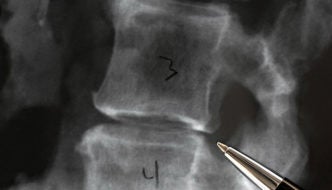Can a diet high in processed fat and sugar and Type 2 diabetes cause degeneration of intervertebral discs in the spine? If so, what is happening, and can it be prevented? As part of an ongoing collaboration between Rensselaer and the Icahn School of Medicine at Mount Sinai—a partnership that draws upon the expertise of both schools to address significant health problems—researchers hope to answer those questions by investigating the link between diet, obesity-linked Type 2 diabetes, and intervertebral disc degeneration.
Researchers on the project suspect the diet associated with Type 2 diabetes—one high in processed fats and sugars—causes inflammation and modification of disc tissue, triggering a chain of responses, which leads to degeneration. To test this hypothesis, the researchers have set three goals: to establish whether mice fed a diet associated with Type 2 diabetes will develop intervertebral disc degeneration (IDD), isolate the effect of diet-causing changes in the tissue, and evaluate how the diet modifies proteins within the disc.
The project is supported by a $3.3 million grant from the National Institutes of Health and is led by Dr. James Iatridis, a professor and vice chair for research in the orthopaedics department at the Icahn School of Medicine.
 “Back pain caused by spinal disc degeneration is the number one cause of global disability, so it’s a hugely important problem that needs to be addressed,” said Iatridis, who has long specialized in spinal disc degeneration.
“Back pain caused by spinal disc degeneration is the number one cause of global disability, so it’s a hugely important problem that needs to be addressed,” said Iatridis, who has long specialized in spinal disc degeneration.
Deepak Vashishth, a professor of biomedical engineering and the Rensselaer lead on the project, said the partnership makes it possible to tackle a project of this complexity.
“We’re trying to establish the mechanism whereby this diet, and Type 2 diabetes, leads to disc degeneration, and that’s not an easy thing to do because, within the body, various processes are linked and feedback loops are difficult to unravel,” said Vashishth, who is also the director of the Center for Biotechnology and Interdisciplinary Studies. “To investigate this question, you need the mix of experts from different disciplines with different skill sets that the partnership allows.”
At the core of the research project are the effects of advanced glycation end-products (AGE)—proteins or lipids that have become coated in sugars, which damage their function. Research suggests that a diet high in heat-processed foods, including fried foods, plays a role in AGE formation. Research also indicates the accumulation of AGEs causes structural deterioration, increases inflammation that could lead to disc degeneration, and contributes to a host of degenerative diseases such as diabetes, atherosclerosis, and Alzheimer’s.
In the first part of the project, researchers at Mount Sinai will raise mice—both regular mice and so-called “knock-out” mice that have been genetically modified to reduce the ability of their cells to bind to AGEs—on a diet of foods high in AGEs, accelerating AGE accumulation in the mice, and observing whether the mice develop the various health conditions associated with Type 2 diabetes, including disc degeneration. This part of the research helps establish the systemic effects of AGEs on the body.
At Rensselaer, researchers will analyze various mouse and human tissue samples, helping to determine how healthy disc tissue in humans and mice differ from the tissue of patients and mice that have developed disc degeneration, as well as mice that have been treated with a drug intended to block the effects of a diet high in AGEs on the spine.
“We’ll look for a qualitative and a quantitative match,” Vashishth said. “So we’ll want to know if we’re seeing the same modifications in both the mice and humans that present with degenerated discs, how much modification there is based on the diet, and in cases where a drug was used for treatment or prevention, we’ll see whether those modifications are reduced.”
Vashishth, an expert in extracellular bone matrix, has a long-term interest in investigating AGE-accumulation in bone. With his expertise, the team will also look at how changes in bone could be contributing to the degeneration of discs. Vashishth said one aspect of the feedback loop may be causing bone tissue in the spinal vertebrae to stiffen, depriving disc tissue of nutrients that would normally diffuse through the bone to the discs.


